Tiverton has some extraordinary veterans buried in her historical cemeteries around Town. Here are six of them…
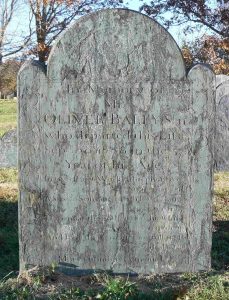 Private Oliver Baley, Senior
Private Oliver Baley, Senior
Revolutionary War
Oliver Baley was born on September 25, 1721 in Little Compton to Lieutenant Thomas and Mary Wood Baley. He was baptized in the Little Compton Congregational Church on December 8th.
The same church register records: “These may certifie that Oliver Baley and Ruth Cook of Tiverton were legally married October the 19th Day 1743 per Richard Billings [word illegible] minister in Little Compton.” They had three children: Oliver, Comfort, and Philip.
In 1778, Baley served as a Private in Captain Isaac Cook’s company of Colonel Nathan Miller’s militia regiment from the State of Rhode Island. Other surnames in the Company are other Tiverton and Little Compton family names: Manchester, Cook, Almy, Cory, Sanford, Lake, Tabor.
He died on September 20, 1778 in Tiverton, where he is buried along with his family in the Congregational Cemetery, Historical Cemetery #11. His daughter, Comfort, died a month before on August 10th, and his namesake son died on September 8th. This explains his epitaph carved by John Stevens III:
In two short weeks this plaintive one may tell
A Sire, a Son, and much loved Daughter fell
Here near the Father’s feet his Children sleep
And long the Tomb its awfull trust shall keep
Mors Omnibus Communis
[translated: death is common to all things]
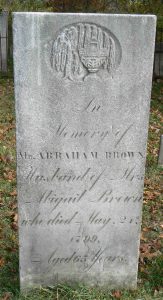
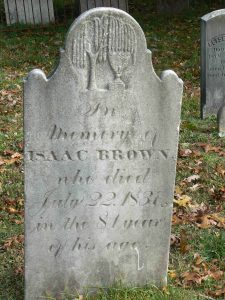 Privates Abraham and Isaac Brown
Privates Abraham and Isaac Brown
Revolutionary War
Abraham Brown was born on January 1, 1734 to Abraham and Sarah Cory. He married Abigail Wilbur in 1756 and they had ten children: twins Isaac and Benjamin, Abraham, Abigail Brown Judson, Elizabeth, Mary Tullar, Elizabeth, Sarah, William, and Pardon.
His father built the first Brown house on Main Road, and Abraham added to it. He built the front part of the house, north of and including the front hall and door. He served as a Private in Captain Isaac Cook’s Company in Colonel John Cook’s Regiment from 1775 to 1778. He hosted the Marquis de Lafayette during his stay in Tiverton in 1778. From that point on, the house was nicknamed “The Lafayette House”.
After the War, Abraham was appointed director of the lottery, working with Joseph Taber, Pardon Gray, John Cooke, William Ladd, William Whitridge, Benjamin Howland, and Nathaniel Briggs. The lottery was formed to raise $1500 to repair the Meeting House of the Congregational Society that was used as troop barracks during the Revolutionary War.
Isaac Brown, Abraham’s son, was a Private in Captain Isaac Cook’s Company of Colonel John Cook’s Regiment from 1776 to 1779. In 1780, he was in Captain Peleg Simmons’ Company. Isaac married Hannah Cook, daughter of Jeremiah and Constant Russell Cook, in 1786.
He also added to the Brown house, building on the southern part of the house in 1812; the south side of the present front entrance. Isaac divided his homestead farm in 1828 between his two sons, Adoniram and Abraham, indicating that Adoniram was to have the southern part and Abraham was “to have all the North or ancient part of the Dwelling house.”
Both are buried in the Congregational Cemetery, Historical Cemetery #11.
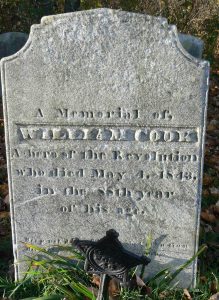 Private William Cook
Private William Cook
Revolutionary War
William Cook enlisted as a Private in “boat service” in Captain Christopher Manchester’s Company of Colonel Smith’s Rhode Island Regiment in 1777. He continued as a Private under Captain Manchester, but part of Colonel Archibald Crary’s Rhode Island Regiment from 1777 to 1778. In 1778, he was in the 1st Division under Captain Isaac Cook’s Rhode Island Regiment, and was part of General Sullivan’s Expedition on Rhode Island (a.k.a. Aquidneck Island).
The following year, he was in Captain Benjamin Borden’s Company on Fogland. He ended his service as a Private in Captain Peleg Simmons’ Company of Colonel Bailey’s Rhode Island Regiment in 1780. His years of service to his country proved him to be “A Hero of the Revolution”, as his gravestone states.
William was born on November 7, 1755 in Tiverton to Walter and Elizabeth Hall Cook. He married Ruth Tabor, who was widow of a Clarke. They had seven children: John, Cynthia Ann Peckham, David, Sarah Hillard, Lydia Manchester, Mary Manchester, and Catherine.
He died on May 4, 1843 in Tiverton and is buried in the Congregational Cemetery, Historical Cemetery #11.
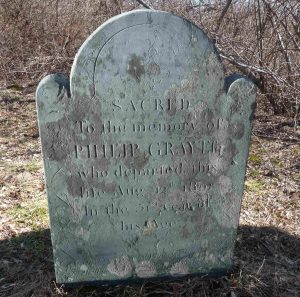 Philip Gray, Esquire
Philip Gray, Esquire
Revolutionary War
In 1776, Philip Gray was a Prize Master, being a privateer with his ship “Lady Washington.” In 1778, he was a Private in Captain Isaac Cook’s Company and Colonel John Cook’s Regiment.
The “Esquire” on his headstone and his Will indicates Philip Gray may have also been a lawyer. As Prize Master, he was tasked to keep records on prize ships and cargo taken. Thus, he had to be literate and numerate.
Philip was born on June 22, 1750 in Tiverton to Philip Gray, Sr. and Sarah Cory. His brother was Pardon Gray. Philip married Deborah Bailey in Little Compton in 1768. They had nine children: Scynthia Hart, Prudence Maguire, Ellery, Mary Corey, Phillip, Sarah, John, Deborah Waite, and Edward.
Philip died on August 12, 1801 and is buried with his parents in the family plot, Historical Cemetery #21 in Tiverton.
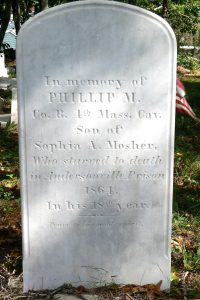 Private Philip Mosher
Private Philip Mosher
Civil War
Phillip Mosher was born in Warren in 1847 to Philip and Sophia Ann Lake Mosher. He enlisted as a Private in Company B, 4th Massachusetts Calvary Regiment in the Civil War.
The Second Battalion (Companies A, B, C, and D) sailed from Boston for Hilton Head, S.C. on the steamer Western Metropolis on March 20, 1864, arriving on April 1st. They conducted picket and outpost duty at Hilton Head until June. Two Companies moved to Jacksonville, Florida in early June, and participated in a skirmish at Front Creek on July 15, 1864, and another from Jacksonville upon Baldwin July 23-28. Other skirmishes occurred at South Fork, Black Creek on July 24th and at St. Mary’s Trestle two days later. They raided the Florida Railroad on August 15-19, and fought at Gainesville on August 17th.
Mosher was captured at Gainesville and was confined to the Andersonville, Georgia Prison where he died of starvation. This stone in Historical Cemetery #23 may be a memorial to his life.
From a personal recollection of Charles Smith of Company E, Massachusetts Cavalry, imprisoned there in March of 1864: 31,000 men in a pen, on the bare earth, exposed to the fierce rays of the southern sun, the drenching showers, the cold night dews, covered with vermin and sores….Neither shade nor shelter was afforded us, nor clothing issued….Some had been in prison many months, and were reduced by starvation and wasted by disease….Crowding and filth were nearly as fatal to the prisoners as starvation….Through the center…ran a filthy sluggish stream, four or five feet wide and six inches deep. This stream, which was the receptacle of the offal and filth of our camp, a Confederate camp, and the prison cook-house, was our water supply….The original inclosure[sic] contained…about 12 Acres; and this, when the number of prisoners was greatest (31,000) gave to each man about 17 square feet….The number of square feet required for an ordinary adult’s grave is about the same.
Remember these brave veterans of Tiverton – and thank a veteran this November!
[Histories and Gravestones from the Tiverton Historical Preservation Advisory Board/Tiverton Historical Cemeteries Commission exhibited at the Town Hall in May of 2019; currently in the flat files in the History Room of the Tiverton Public Library]
